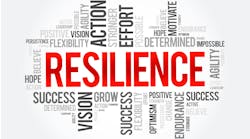Allen Iverson was 5 feet, 11 inches tall and yet one of the most feared opponents in the NBA. I’m not a basketball fan by any stretch, in fact I haven’t watched a game in 10 years. But when Allen Iverson played, I found myself watching. How was he so competitive in a sport where size does matter? He had the indefensible gift of blazing speed. Jackie Robinson possessed blazing speed so hard to ignore he changed the social fabric of baseball. And due to their ability to run faster than the rest, Bo Jackson and Deion Sanders each excelled in both the NFL and MLB.
I could continue citing example after example of how speed is indispensable in many other areas of life, but the one I want to dig into is the speed in which a vehicle is repaired. I attended a 20 Group meeting in 2004 and wrote a simple statement down on a ripped piece of paper that became the driving force behind most of my decisions over the last 20 years. That statement helped our company make several moves that kept us competitive in a hotly contested market. The statement is this: “In business, the big will not eat the small, the fast will eat the slow.” I can think back to several instances where I was concerned we would lose market share to another competitor for one reason or another. And then I would think back to that statement and realize no one was in control of how fast we repaired a vehicle.
If you are alive in the collision industry, then you’ve surely uttered the words that our labor rates are too low. And no doubt they are. But when you are getting 30 hours to repair a vehicle and can get it completed in 15 hours, the actual labor rate is far greater than the paid rate. Let’s say X insurance company gives you $50/hour, in that scenario you are technically getting paid $100/hour since you completed the repair in half the time, assuming you work in an hourly environment. You possess the ability to give you and your staff a rate increase, just by getting faster.
Have you had trouble finding people to hire? Sorry, I know that is a rhetorical question. Finding ways to repair a vehicle faster allows you to get more work done with less people. I’ve written before about how the first time we achieved $2 million in sales we had a staff of 14. The next time we hit $2 million in sales, two years later, we had a staff of nine. The first year we hit that sales goal was when we started getting serious about implementing processes into our company. The more processes we had, the faster we fixed a vehicle, which increased our sales. And two years later we hit it again, with a huge reduction in staff. Finding more bodies is the difficult way to get more vehicles repaired and increase sales. Implementing processes is the more profitable, and far easier, way to increase sales.
I believe one of the ways to set your company up for future success is to repair vehicles with better quality than anyone else. Top craftsmanship has been valued by every stakeholder in the industry for years. So, what about the argument that quality and speed can’t go hand in hand? I can’t tell you how many times I’ve heard that if you speed up the process the quality will go down. I have found that exact opposite to be true. Today’s vehicles are built in a way that cutting corners in repairs only slows you down, once you have to go back and fix what wasn’t done properly the first time and is now causing fitment issues, dash lights, etc.
One of the reasons we are slow at repairing vehicles in our industry is from starting and stopping so many times. How many techs have told you they could do a better job on the repair if they didn’t have to get interrupted so many times by switching back and forth from one vehicle to another? Starting to repair a vehicle with all the parts and all the OE procedures allows a tech to do their job uninterrupted which almost always results in a higher quality repair that takes less time to do.
The easiest way to get faster at repairing vehicles, and I’m talking Allen Iverson fast, is to do the necessary prep work at the beginning of the process. Partnering OE procedure research with a complete disassembly will eliminate so many hurdles in the repair. Organizing equipment, materials, and tools will help everyone find what they need when they need it. Both of these steps will also reduce stress on your workforce, which will positively impact how quickly they do their job. And a less stressful environment typically equates to a higher retention rate.
Regardless of which struggle you are currently facing, remember that speed will almost always be your best offense to overcome that struggle. Remember, in business, the big will not eat the small, the fast will eat the slow.




